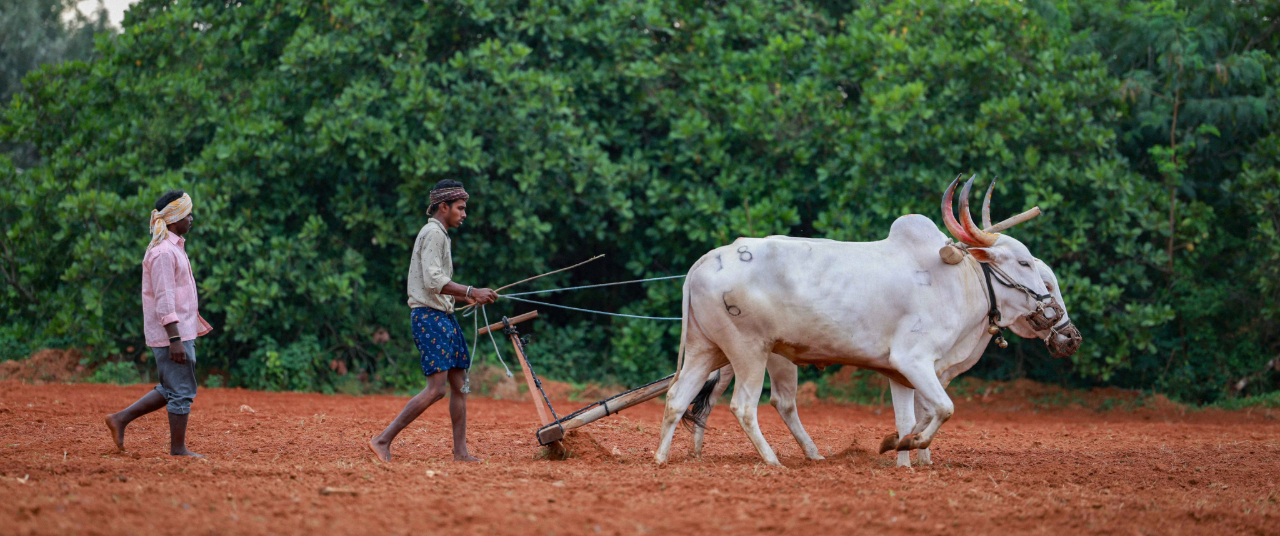Syncing with the monsoon is important for a rain-fed crop like ragi; sowing too early or late has a direct effect on harvests






Editor's note: Even before its current status as a nutrient-rich superfood, ragi has been a crucial chapter in the history of Indian agriculture. Finger millet, as it is commonly known, has been a true friend of the farmer and consumer thanks to its climate resilience and ability to miraculously grow in unfavourable conditions. As we look towards an uncertain, possibly food-insecure future, the importance of ragi as a reliable crop cannot be understated. In this series, the Good Food Movement explains why the millet deserves space on our farms and dinner plates. Alongside an ongoing video documentation of what it takes to grow ragi, this series will delve into the related concerns of intercropping, cover crops and how ragi fares compared to other grains.
Every cropping season in India begins not with a seed, but with the sky. For generations, farmers have read the rhythms of the monsoon like a living calendar—each phase of rain marking a specific agricultural activity. In Karnataka’s dryland regions, this relationship between rain, soil, and crop choice forms the foundation of sustainable farming.
The Good Food Movement is growing ragi on a 2-acre plot in Tumakuru district’s Tiptur town using traditional, organic methods and documenting the entire process, from sowing cover crops, to choosing the right seeds, to planting, sowing and harvesting.
This article aims to provide an overview of the cropping conditions in Tiptur to understand what goes behind a successful ragi harvest cycle in these dryland landscapes.
Understanding the geography
Karnataka is divided into the more forested regions of Malnad in the West and the open lands of the Maidan in the East, each with its own land use and settlement culture. Agriculture is more commonly practised in the expanses of the Maidan. Tiptur sits in the South Maidan zone of Karnataka. This is a semi-arid region characterised by red-brown soils and undulating terrain. Tiptur’s landscape in particular is home to vivid red, loamy soils.
The region’s average annual rainfall ranges between 700-900 mm. Tiptur, being on the leeward side of the Western Ghats, is on the lower range of this rainfall spectrum, receiving about 680-720 mm. Most of this rainfall occurs during the southwest monsoon (June to September), which nourishes the Kharif crop cycle. Average temperatures stay between 24°C and 34°C across the year. These conditions make Tiptur ideal for millets like ragi, along with pulses and oilseeds that thrive in well-drained soils and intermittent rainfall.
Each phase guides what happens on the farm, from preparing the land and sowing cover crops, to mulching, and the final sowing of ragi.
In this landscape, rain is a planning tool. Farmers track the traditional nakshatra (constellation)-based rain calendar, using the names of constellations like Revathi, Ashwini, and Rohini to track rains throughout the year. In Kannada, Mungaru refers to the crucial southwest monsoon, while the Hingaru or northeast monsoon (October–December) supports Rabi crops. Each phase guides what happens on the farm, from preparing the land and sowing cover crops, to mulching, and the final sowing of ragi.
Also read: Why Akkadi Salu, an ancient practice of intercropping ragi, deserves a comeback
Pre-monsoon preparations
The cropping season begins around March-April, long before the main monsoon showers arrive. Farmers begin tilling and preparing their fields, before the first Revathi rains. This is followed by the sowing of cover crops—crops that are grown before the main crop to prevent soil erosion and replenish soil nutrients. Though there isn't a fixed rule for which crops to select, it is recommended to incorporate 80% as legumes for nitrogen fixation and 20% as non-legumes to maintain diversity. In our experiment, we used a mix of sunn hemp, spiny sesbania, horsegram, mustard, sesame and cowpea.
This stage, often overlooked in conventional agriculture, is crucial for restoring the land. The cover crops fix nitrogen, protect the topsoil from heat and erosion, and naturally add biomass once they are mixed back into the soil. As they mature, often growing 4–6 feet tall by the onset of the Mungaru rains in June, they create a dense green canopy which lowers soil temperatures, compared to land exposed to the sun.
The arrival of the southwest monsoons in June marks the onset of the Kharif crop cycle. The matured cover crops are tilled back into the soil using a rotavator in time for planting the main ragi crop. This produces green manure, a natural nutrient source that boosts soil fertility and microbial life. Around 16 tons of fresh biomass per acre can be generated in this phase, part of which contributes to long-term soil carbon.
Also read: A crop for the future: Why India should invest in ragi and its climate resilience
The Kharif cycle and the rains
It’s important to sync the harvest cycle of ragi, a hardy millet and dietary staple in this region, with the Kharif monsoon cycle. Cover crops are sown to align with the onset of the first Ashwini rains. Thereafter, ragi is typically sown in late July—once the soil has absorbed sufficient monsoon moisture and the decomposed biomass. Farmers rely on consistent showers during the Pushya and Ashlesha (mid-July to mid-August) rains to aid germination. The Tumakuru district experiences the last of its rainfall in mid-October. By this time, the crop should have reached a healthy maturation rate of 70-80% so that it can be harvested in November. Syncing with the monsoon is especially important for a rain-fed crop like ragi: if you sow too early, harvesting might become difficult during heavy rains. Sow too late, and the soil may lose its moisture.
Rainfall patterns in Tiptur have become increasingly erratic over the last 5 years, in terms of both the number of rainy days and the quantum of rainfall received during a specific period. Delays during Mrigashira and Ardra (June and early July) mean that cover crops mature under limited moisture, forcing farmers to adapt dynamically—sometimes switching to short-duration millet or pulse varieties if rains fail to arrive on time.
This adaptive approach—watching the skies, responding to soil feedback, and making crop decisions in real-time—is the essence of rain-fed agriculture. Unlike irrigated systems, farmers here depend entirely on the sequencing of natural rainfall, balancing risk and regeneration.
This adaptive approach—watching the skies, responding to soil feedback, and making crop decisions in real-time—is the essence of rain-fed agriculture.
The red loamy soil of Tiptur is moderately low in organic carbon—which makes regenerative practices like cover cropping essential. Integrating organic manure and green biomass helps rebuild the soil’s structure, improving its ability to retain moisture and nutrients during dry spells.
By sequencing operations with each nakshatra calendar, farmers turn uncertainty into a working rhythm. Land is prepared and a layer of mixed cover crops is sown during the pre-summer rains. These grow into a canopy, and are re-incorporated into the soil during the early monsoon at the beginning of the Kharif season. Ragi is sown once the soil absorbs the biomass, and is then harvested when the spikes turn brown.
Agriculture is a dialogue between soil ecology and seasonal uncertainty. The Kharif cycle, too, isn’t merely a harvest calendar or a farming schedule. Each rainfall event, each temperature shift, reshapes the farmer’s decisions. Through cover cropping, green manuring, and careful timing, the land learns to breathe again between harvests.
Also read: The grain divide: How ragi and rice compare in the field and on our plates
Explore other topics
References






.avif)

.jpg)


